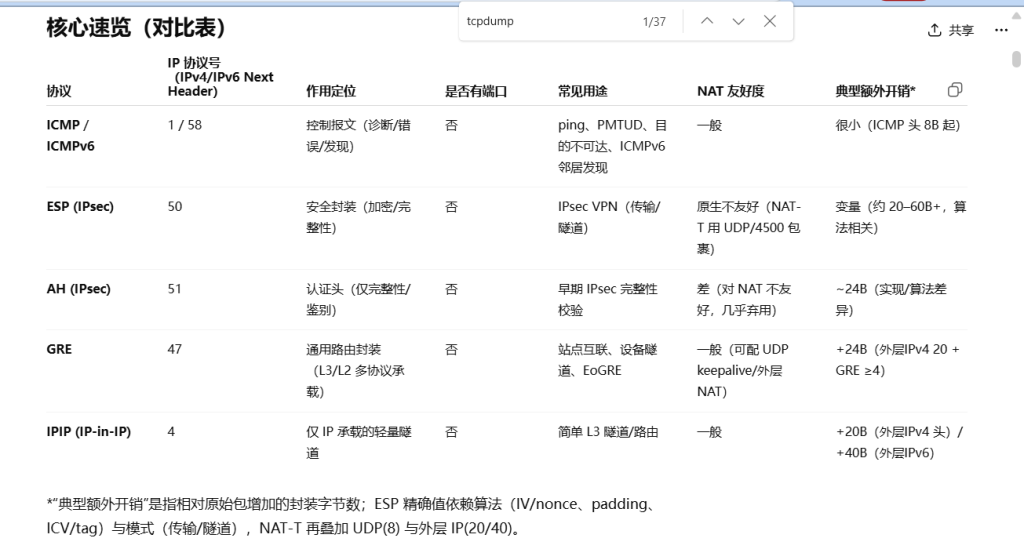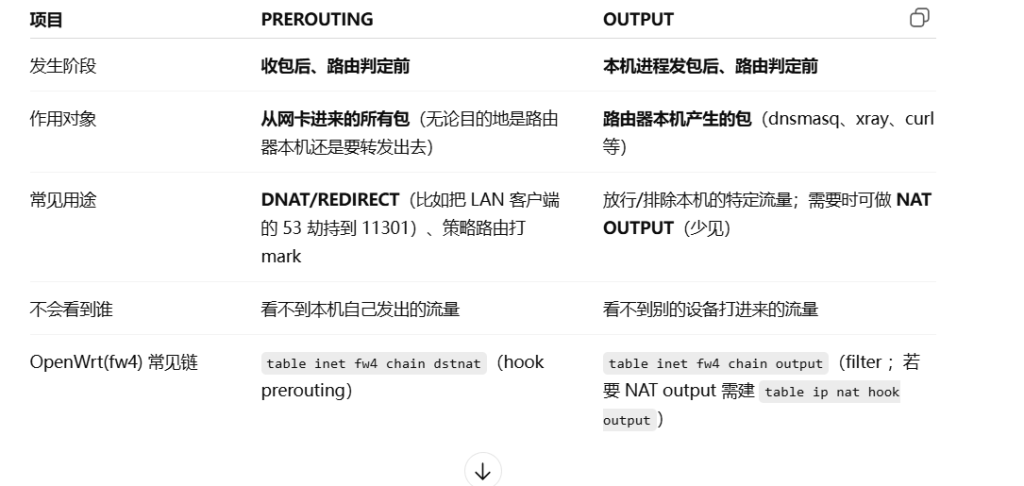wireguard 客户端可以配置成, 根据 IP 段选择 连接对应的wireguard 服务器端? 例如 wireguard 客户端IP 为 192.168.10.0/24 时, 连接 wireguard 服务器A端, 33.33.33.33 wireguard 客户端IP 为 192.168.20.0/24 时, 连接 wireguard 服务器B端, 44.44.44.44 wireguard 客户端IP 为 192.168.30.0/24 时, 连接 wireguard 服务器C端, 55.55.55.55 wireguard 客户端 安装在openwrt 中, wireguard 服务器端 安装到 centos 服务器中, 有 3台服务器 A,B, C
解决方案
方案一:用 luci-app-pbr(VPN Policy-Based Routing)
1) 安装
opkg update
opkg install luci-app-pbr pbr
#(如未装 WG)
opkg install wireguard-tools kmod-wireguard
2) 配 3 条 WireGuard 接口(/etc/config/network)
关键点:三个接口分别指向 33.33.33.33 / 44.44.44.44 / 55.55.55.55;为避免默认路由被抢占,关闭 route_allowed_ips(或 AllowedIPs 不设 0.0.0.0/0)。
config interface 'wgA'
option proto 'wireguard'
list addresses '10.8.0.2/32' # 你在 A 服务器分给 OpenWrt 的隧道 IP
option private_key 'XXXXX'
option peerdns '0'
option mtu '1420' # 视需要调整
option metric '50' # 防止干扰主路由
config wireguard_wgA
option public_key 'PUBKEY_A'
option endpoint_host '33.33.33.33'
option endpoint_port '51820'
option persistent_keepalive '25'
list allowed_ips '0.0.0.0/0' # 让隧道可承载全流量
option route_allowed_ips '0' # 但不自动加默认路由
config interface 'wgB'
option proto 'wireguard'
list addresses '10.9.0.2/32'
option private_key 'YYYYY'
option peerdns '0'
option mtu '1420'
option metric '50'
config wireguard_wgB
option public_key 'PUBKEY_B'
option endpoint_host '44.44.44.44'
option endpoint_port '51820'
option persistent_keepalive '25'
list allowed_ips '0.0.0.0/0'
option route_allowed_ips '0'
config interface 'wgC'
option proto 'wireguard'
list addresses '10.10.0.2/32'
option private_key 'ZZZZZ'
option peerdns '0'
option mtu '1420'
option metric '50'
config wireguard_wgC
option public_key 'PUBKEY_C'
option endpoint_host '55.55.55.55'
option endpoint_port '51820'
option persistent_keepalive '25'
list allowed_ips '0.0.0.0/0'
option route_allowed_ips '0'
防火墙:把 wgA/wgB/wgC 加到一个 vpn zone(出方向 ACCEPT,或转发到 WAN),LAN 允许 forward 到 vpn。
3) 策略路由(/etc/config/pbr)
config pbr 'config'
option enabled '1'
option strict_enforcement '1'
option verbosity '1'
config policy
option name 'LAN10_to_A'
option src_addr '192.168.10.0/24'
option interface 'wgA'
config policy
option name 'LAN20_to_B'
option src_addr '192.168.20.0/24'
option interface 'wgB'
config policy
option name 'LAN30_to_C'
option src_addr '192.168.30.0/24'
option interface 'wgC'
重启网络/服务:
/etc/init.d/network restart
/etc/init.d/pbr restart
4): DNS 防泄漏
/etc/config/dhcp(dnsmasq)
- 关闭本机 DNS 监听(只当 DHCP 不当 DNS)
- 各网段通过 DHCP option 6 下发各自专属 DNS
你可以用自己三台服务器的隧道侧地址(例如在服务器 A/B/C 上监听10.8.0.1/10.9.0.1/10.10.0.1的递归或转发 DNS),也可以用公共 DNS。下面给两套写法,你选其一。
config dnsmasq
option domainneeded '1'
option boguspriv '1'
option authoritative '1'
option noresolv '1'
option port '0' # 关闭本机53端口,路由器不提供DNS
# 按你的实际接口名修改(示例假设 br-lan10/20/30 对应的 dhcp 段名为 lan10/lan20/lan30)
config dhcp 'lan10'
option interface 'lan10'
option start '100'
option limit '100'
option leasetime '12h'
# 下面两行二选一(只保留你选的那行!)
# 【A 方案:用服务器A的隧道侧DNS】(建议跑 unbound/dnsmasq 在 10.8.0.1)
# list dhcp_option '6,10.8.0.1'
# 【B 方案:用公共DNS(示例Cloudflare)】
list dhcp_option '6,1.1.1.1,1.0.0.1'
config dhcp 'lan20'
option interface 'lan20'
option start '100'
option limit '100'
option leasetime '12h'
# 【A:服务器B】
# list dhcp_option '6,10.9.0.1'
# 【B:公共DNS(示例Google)】
list dhcp_option '6,8.8.8.8,8.8.4.4'
config dhcp 'lan30'
option interface 'lan30'
option start '100'
option limit '100'
option leasetime '12h'
# 【A:服务器C】
# list dhcp_option '6,10.10.0.1'
# 【B:公共DNS(示例Quad9)】
list dhcp_option '6,9.9.9.9,149.112.112.112'
若采用【A 方案】,请在三台 CentOS 上各自开一个本地 DNS(unbound/dnsmasq 任一),监听隧道 IP(如 10.8.0.1),并允许递归到公网;这样天然“所有 DNS 一定走隧道”。
5): /etc/config/firewall(严格拦截 53,只放行白名单 DNS)
为每个网段添加两条规则:允许到“白名单 DNS”的 53、拒绝其它 53。
(下面示例分别给出 A/B 两种上游写法,保留你实际使用的 IP)
######## LAN10 -> 只许到 A 方案的 10.8.0.1(或 B 方案的 1.1.1.1/1.0.0.1) ########
config rule
option name 'LAN10 allow DNS to A(or CF)'
option src 'lan10'
option proto 'tcpudp'
option dest_port '53'
# A 方案(服务器A在隧道侧的DNS)
# option dest_ip '10.8.0.1'
# B 方案(Cloudflare)
option dest_ip '1.1.1.1 1.0.0.1'
option target 'ACCEPT'
config rule
option name 'LAN10 block other DNS'
option src 'lan10'
option proto 'tcpudp'
option dest_port '53'
option target 'REJECT'
######## LAN20 -> 只许到 B 方案的 10.9.0.1(或 8.8.8.8/8.8.4.4) ########
config rule
option name 'LAN20 allow DNS to B(or Google)'
option src 'lan20'
option proto 'tcpudp'
option dest_port '53'
# A 方案(服务器B)
# option dest_ip '10.9.0.1'
# B 方案(Google)
option dest_ip '8.8.8.8 8.8.4.4'
option target 'ACCEPT'
config rule
option name 'LAN20 block other DNS'
option src 'lan20'
option proto 'tcpudp'
option dest_port '53'
option target 'REJECT'
######## LAN30 -> 只许到 C 方案的 10.10.0.1(或 9.9.9.9/149.112.112.112) ########
config rule
option name 'LAN30 allow DNS to C(or Quad9)'
option src 'lan30'
option proto 'tcpudp'
option dest_port '53'
# A 方案(服务器C)
# option dest_ip '10.10.0.1'
# B 方案(Quad9)
option dest_ip '9.9.9.9 149.112.112.112'
option target 'ACCEPT'
config rule
option name 'LAN30 block other DNS'
option src 'lan30'
option proto 'tcpudp'
option dest_port '53'
option target 'REJECT'
6): 服务器端(CentOS)最小可用示例(每台一份)
以 A 为例(B/C 同理改端口与网段):
/etc/wireguard/wg0.conf
[Interface]
Address = 10.8.0.1/24
ListenPort = 51820
PrivateKey = <SERVER_A_PRIVKEY>
# 打开转发 + NAT(iptables 版本,nft/火墙按需替换)
PostUp = sysctl -w net.ipv4.ip_forward=1 ; iptables -t nat -A POSTROUTING -o eth0 -j MASQUERADE
PostDown = iptables -t nat -D POSTROUTING -o eth0 -j MASQUERADE
[Peer]
# OpenWrt(wgA)的公钥
PublicKey = <OPENWRT_PUBKEY_FOR_A>
AllowedIPs = 10.8.0.2/32
B/C 建议用不同的隧道网段(如 10.9.0.0/24、10.10.0.0/24),便于区分与排错。
启动:
systemctl enable --now wg-quick@wg0
7): 在 CentOS 服务器上开“隧道侧 DNS”
举例:在 A 服务器(10.8.0.1)用 dnsmasq 作转发器(轻量、够用),B/C 同理改 IP。
/etc/dnsmasq.d/wg-dns.conf:
# 仅监听隧道口
interface=wg0
listen-address=10.8.0.1
bind-interfaces
no-resolv
# 上游你可选 Cloudflare/Google/Quad9 等
server=1.1.1.1
server=1.0.0.1
cache-size=1000
启动并自启:
systemctl enable --now dnsmasq方案二:纯 UCI 手工(多路由表 + ip rule)
1) 同上先建 3 条 WG 接口(与方案一相同),保持 route_allowed_ips '0'。
2) 自定义路由表与规则(/etc/config/network)
# 路由表 101/102/103:默认走各自的 wg 接口
config route
option interface 'wgA'
option target '0.0.0.0'
option netmask '0.0.0.0'
option table '101'
config rule
option src '192.168.10.0/24'
option lookup '101'
option priority '1010'
config route
option interface 'wgB'
option target '0.0.0.0'
option netmask '0.0.0.0'
option table '102'
config rule
option src '192.168.20.0/24'
option lookup '102'
option priority '1020'
config route
option interface 'wgC'
option target '0.0.0.0'
option netmask '0.0.0.0'
option table '103'
config rule
option src '192.168.30.0/24'
option lookup '103'
option priority '1030'/etc/init.d/network restart
3):给每个表加“默认走 wgX”的路由(/etc/config/network)
##### 表101:默认经 wgA #####
config route
option interface 'wgA'
option target '0.0.0.0'
option netmask '0.0.0.0'
option table '101' # => ip route add default dev wgA table 101
#(如用IPv6,同样建一条默认路由到 wgA)
# config route6
# option interface 'wgA'
# option target '::'
# option netmask '0'
# option table '101'
##### 表102:默认经 wgB #####
config route
option interface 'wgB'
option target '0.0.0.0'
option netmask '0.0.0.0'
option table '102' # => default dev wgB
# config route6
# option interface 'wgB'
# option target '::'
# option netmask '0'
# option table '102'
##### 表103:默认经 wgC #####
config route
option interface 'wgC'
option target '0.0.0.0'
option netmask '0.0.0.0'
option table '103' # => default dev wgC
# config route6
# option interface 'wgC'
# option target '::'
# option netmask '0'
# option table '103'
用策略规则把各源网段指向对应表(/etc/config/network)
##### LAN10 -> 表101 -> wgA #####
config rule
option src '192.168.10.0/24'
option lookup '101'
option priority '1010'
##### LAN20 -> 表102 -> wgB #####
config rule
option src '192.168.20.0/24'
option lookup '102'
option priority '1020'
##### LAN30 -> 表103 -> wgC #####
config rule
option src '192.168.30.0/24'
option lookup '103'
option priority '1030'
编辑 /etc/iproute2/rt_tables 末尾追加:
101 t_wgA
102 t_wgB
103 t_wgC
应用并自检
/etc/init.d/network restart
# 查看规则与表
ip rule
ip route show table 101
ip route show table 102
ip route show table 103
# 看 WG 是否在传数据
wg show


